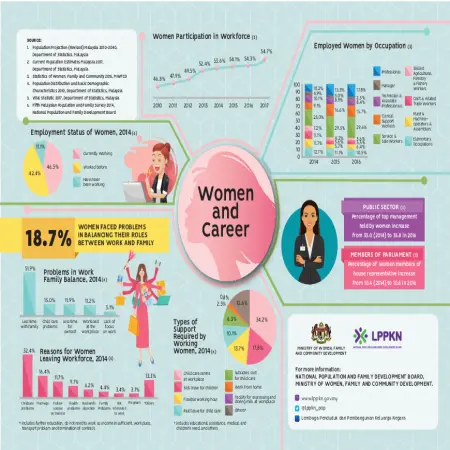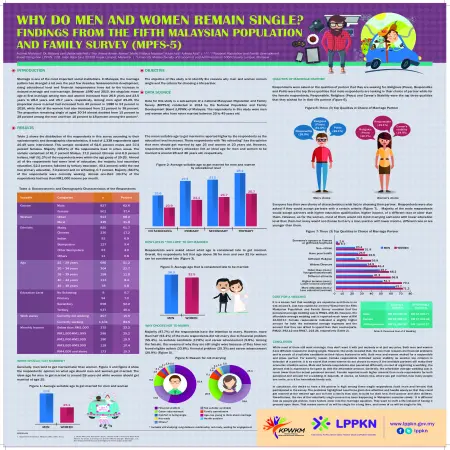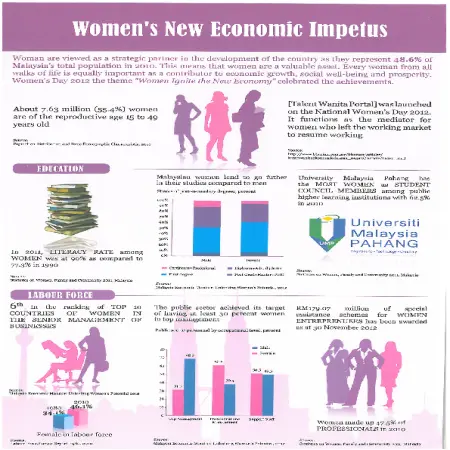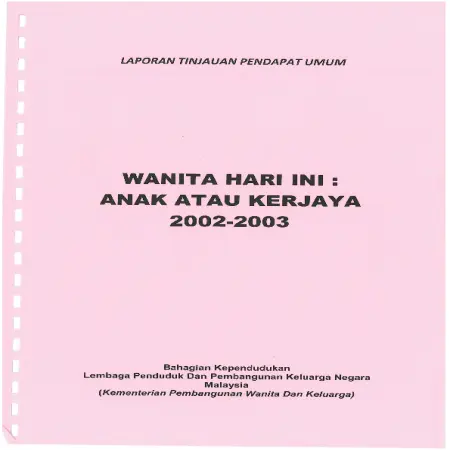PUBLICATIONS
|
|
Why do men and women remain single? Findings from the Fifth Malaysian Population and Family Survey (MPFS-5)
Item Type: Scientific Poster
Editor:
Year: 01/07/2015
Abstract: Marriage is one of the most important social institutions. In Malaysia, the marriage pattern has changed a lot over the past few decades. Socioeconomic development, rising educational level and financial independence have led to the increase in delayed marriage and non-marriage. Between 1980 and 2010, the singulate mean age at first marriage among men and women increased from 26.6 years and 23.5 years to 28.0 years and 25.7 years, respectively. Among men aged 25-29, the proportion never married had increased from 40 percent in 1980 to 53 percent in 2010, while that of the women had also increased from 21 percent to 38 percent. The proportion remaining single at aged 30-34 almost doubled from 15 percent to 28 percent among the men and from 10 percent to 18 percent among the women. The objective of this study is to identify the reasons why men and women remain single and the criteria for choosing a life partner.
|
|
|
|
|
|
Women's new economic impetus
Item Type: Infographic
Editor:
Year: 00/12/2012
Abstract: Women are viewed as strategic partner in the development of the country as they represent 48.6% of Malaysia's total population in 2010. This means that women are a valuable asset. Every woman from all walks of life is equally important as a contributor to economic growth, social well-being and prosperity.
|
|
|
|
|
|
Work-life balance among mothers in Peninsular Malaysia
Item Type: Book Section
Editor:
Year: 01/01/2011
Abstract: Achieving work-family balance is dependent on managing the conflict between work and family roles. This study focuses on the prevalence of work-family conflict among mothers in Peninsular Malaysia. The objective of this study is to examine the relationship between perceived work-family conflict and socio-demographic and family characteristics of the mothers.
|
|
|
|
|
|
Wanita hari ini: anak atau kerjaya 2002-2003
Item Type: Research Report
Editor:
Year: 00/12/2003
Abstract: The participation of women in the labor force has increased from 37.0 percent in 1971 to 42.0 percent in 1991 and 46.9 percent in 2001. This increase is directly not only increase the number of women working but working spouses. The growing number of working couples has raised some challenges that need to be addressed wisely. Among these challenges is the increasing needs of child care services, maid and time management in discharging its responsibilities as a wife, mother and employee, and that is as important as the son and daughter-in-law for who still have parents and parent-in-law. This study is to explore the extent to which women today give preference between career and family, whether they want to increase the number of children or career development, and the factors that influence their choice. The study sample includes 2.909 women working in the public and private sectors who are 40 years and under, are married and have at least one child aged under 13 years. Overall, the mean number of children a woman is owned by a total of 2.4 people. Meanwhile, the mean ideal number of children who think they are up to 4 people. Nearly 14.0 percent of working couples in conflict between family and career. Due to child care problems, 8.3 percent of women had to quit work and 7.8 per cent had to take leave without pay. New initiatives and implemented if there is a desire to boost the female employees to increase the number of children or not, such as subsidized child care costs, while the policy stops working women, child care services in the workplace, child care services in the area of residence, and flexible working hours.
|
|
|
|









